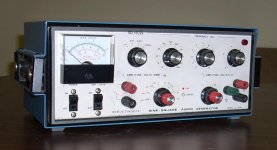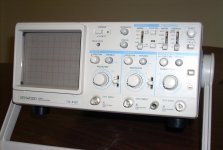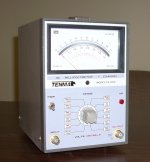So I am in the market for my first signal generator and I really don't have much money to spend. My options are to use an old CD player with a burned CD or there is someone selling a Heathkit Signal Generator IG-82 and a EICO 377 in my area. Are the vintage pieces worth the time or should I just use the CD player?
...or one of the Behringer EQs that also incororates a signal generator. Works for me.
What do you want it for? Do you need a perfect sine? Do you need two? Do you need perfectly consistent amplitude as you sweep? Do you need computer control? Have you considered your PC's sound card? Do you need perfect pink? Audio only or RF too? Do you need accurate frequency or do you have a frequency counter? Do you need any clock or digital trigger outputs?
I've regretted giving away an old old HP...What can I say, I just dig big dials LOL.
What do you want it for? Do you need a perfect sine? Do you need two? Do you need perfectly consistent amplitude as you sweep? Do you need computer control? Have you considered your PC's sound card? Do you need perfect pink? Audio only or RF too? Do you need accurate frequency or do you have a frequency counter? Do you need any clock or digital trigger outputs?
I've regretted giving away an old old HP...What can I say, I just dig big dials LOL.
Last edited:
We once tested a bunch of digital generators ALL of which had too much distortion to test woofers with. I ended up with a used old analog big-dial type.
So the old ones might be good, OR they might not work properly. You need a way to test the generators and measure their distortion.
I also concur: what do you want it for?
So the old ones might be good, OR they might not work properly. You need a way to test the generators and measure their distortion.
I also concur: what do you want it for?
I am looking for one to do basic tests on amps, preamps, etc. I have an o-scope but no signal generator to use with it to test with. I recently build an F5 amplifier that I want to measure to make sure that everything is working perfectly and within spec. I also have a few other amps and preamp I would like to test and modify and need a way to measure what has changed. I don't see myself using a frequency generator often enough to warrant spending a lot of money, but I do need something that is functional.
Unless you can use an oscope to test the distortion of a frequency generator, I have no way to test them.
Unless you can use an oscope to test the distortion of a frequency generator, I have no way to test them.
I often use a CD player with a test tone CD as a signal generator.
You can use your PC sound card and a program like RightMark to test for distortion and frequency response.
Hint: Don't use an expensive sound card until you have all the test procedure and power amplifier bugs worked out.
You can use your PC sound card and a program like RightMark to test for distortion and frequency response.
Hint: Don't use an expensive sound card until you have all the test procedure and power amplifier bugs worked out.
You can use the scope to mostly check the output of the frequency generator, at least to see if there is gross distortion. Low levels like a couple percent may not be obvious visually.
This might work:
LEADER MODEL LAG-120B AUDIO FUNCTION GENERATOR 10 HZ TO 1 MHZ | eBay
which another site says is replaced by
Instek GAG-810 Audio Generator Low Sine Wave Distortion GAG810, GAG 810
But if you don't need precise frequency adjustment then CDs might work just as well.
In neither case can you really tell what's happening with distortion other than on a gross level. The generators are supposed to be low distortion, but if used and old can have gotten out of calibration, broken transistors, etc
This might work:
LEADER MODEL LAG-120B AUDIO FUNCTION GENERATOR 10 HZ TO 1 MHZ | eBay
which another site says is replaced by
Instek GAG-810 Audio Generator Low Sine Wave Distortion GAG810, GAG 810
But if you don't need precise frequency adjustment then CDs might work just as well.
In neither case can you really tell what's happening with distortion other than on a gross level. The generators are supposed to be low distortion, but if used and old can have gotten out of calibration, broken transistors, etc
Well I picked up 2 signal generators for $15. Turns out they are both tube. Only one works. I am not quite sure why the other one doesn't. It shows literally nothing on the o-scope so I am guessing something is loose on the inside. The working one isn't perfect but it gives me a signal.
If I wanted to recap either of these is there any problem with using cheap modern caps as long as they were of the proper V rating?
If I wanted to recap either of these is there any problem with using cheap modern caps as long as they were of the proper V rating?
As long as they are not failed caps, they'll work. Subtle improvements that fancy caps MIGHT provide can wait until you have a chance to work with the units and determine your needs and how well these things meet them.
The circuits are a big oscillator, so anything that stops the oscillation will result in no output. Missing power supply voltages, dead tube, tube socket not making contact, freq selector switches dirty or oxidized and losing contact, lots of things.
The circuits are a big oscillator, so anything that stops the oscillation will result in no output. Missing power supply voltages, dead tube, tube socket not making contact, freq selector switches dirty or oxidized and losing contact, lots of things.
Signal Generator
We have Heathkits IG18 in stock, used but in good working order $50 each.
Other meters and scopes as well
zedaudio@aol.com
Steve
We have Heathkits IG18 in stock, used but in good working order $50 each.
Other meters and scopes as well
zedaudio@aol.com
Steve
Attachments
If I wanted to recap either of these is there any problem with using cheap modern caps as long as they were of the proper V rating?
If you look inside a high quality oscillator like a Krohn-Hite, Tektronix or HP you'll see that the caps are polypropylene, polycarbonate or silver mica, and they were probably selected for precise values.
Of course, it always depends upon what outcome you seek, but there may be no point to replacing the caps with inexpensive ones since results may be worse.
Power supply is a different matter. You might have gotten lucky with electrolytics which haven't dried out.
I just found a guy selling a function generator in the area. Is that able to do the same job?
If you mean one of those skinny ones with sine/square/triangle, that is the class of equipment we found to have higher distortion.
Now, that was some time ago. Maybe they're better today? You can always Google the model number and check out the specs. For audio work you want the sine distortion as 0.0xxxx%, because under controlled circumstances we could definitely hear around 0.something percent (0.3%? 0.1%? I forget exactly)
My experience is to not buy any tube based generators, except maybe the HP 200CD if you are into vintage test gear. Except the HP 200CD, these are mostly unreliable, drift, and for me, more trouble than they are worth.
I also would not buy a function generator to do distortion measurements. These are not clean - 35dB harmonics is typical. Almost every "common" generator you can buy is horrible for distortion, very few better than -50dB.
You need to get a specialized low distortion audio oriented generator, which are rare and pricey, to get better specs than a test tone CD and a CD player, which should easily get you better than -90dB harmonics.
The one built into the HP339A is one, so is the Tek SG-505 both can do -110dB or better.
You can buy the test tone CD, or make your own with free software. Or use a PC and soundcard.
I also would not buy a function generator to do distortion measurements. These are not clean - 35dB harmonics is typical. Almost every "common" generator you can buy is horrible for distortion, very few better than -50dB.
You need to get a specialized low distortion audio oriented generator, which are rare and pricey, to get better specs than a test tone CD and a CD player, which should easily get you better than -90dB harmonics.
The one built into the HP339A is one, so is the Tek SG-505 both can do -110dB or better.
You can buy the test tone CD, or make your own with free software. Or use a PC and soundcard.
Speaking of signal generators...my Behringer digital EQ also made sine, white, pink. When I put a sine into my Newform Ribbons, I was quite shocked at how much the "timbre" changed as I turned up the volume. At low volumes, the sine sounded pure, but as I increased it there was a noticeable change as some raspiness was introduced. And this was not at really extreme levels. I was putting one channel of my amps into each of the 4 ribbons (really narrow mono-polar planar dynamics) so I doubt the amps were anywhere near clipping, though they may have been going out of class a into class b? Someone who shall remain unnamed implied that it was my ears distorting and not the speakers. I should have taken some sound level measurements so I could discuss this intelligently.
Maybe this is just testimony that efficient speakers really do get louder before they distort (these ribbons are NOT very efficient compared to many other high-frequency transducers nor do they really put out a whole lot).
BTW Some "function generators" are meant more for making a clock signal...
Maybe this is just testimony that efficient speakers really do get louder before they distort (these ribbons are NOT very efficient compared to many other high-frequency transducers nor do they really put out a whole lot).
BTW Some "function generators" are meant more for making a clock signal...
How could an HP 200CD come up in two different forums on the same day? See post #29 and check the linked picture.
Well Duh! - Page 3
Well Duh! - Page 3
The old HP tube sine wave generators have served many very well for a long time. That's what they used in the old traveling McIntosh amplifier clinics. Starting out, I wouldn't hesitate to have one. They're not hard to service. They turn up with regularity at hamfests for $25 or so. A slightly newer HP 204 is more compact and doesn't use tubes. Recommended, but harder to service because it's smaller and more crowded. Probably more reliable though. A working General Radio 1310 is a great little generator, but it controls the amplitude with an unobtainable vacuum thermistor, many of which have gone bad. I think it also uses a Nuvistor. I like Waveteks, but I've found many of them need service by now, recaps and sometimes even new IC sockets. They aren't that difficult if you have some experience, but can be a real headache if you don't. OTOH, you'll learn a lot if you have to work on one. They also derive their sine from a triangle, so have that little point on the peak and resulting higher distortion. My favorite is the 185 because it sweeps and has separate knobs for each end of the sweep. The perfect generator hasn't been invented. If you have a scope, it's not that hard to build a very low THD one from scratch using Jim Williams notes from Linear Technology.
Last edited:
Yeah, if you have more time than money then making your own could be very rewarding.
To get the sine even more pure (or even to derive a fairly-decent sine from a triangle), you could also add a tracking post-filter. There's a trick I came up with that I thought was pretty clever: The tracking filter used led-->photocell devices as current-controlled resistors, to change the filter stages' cutoff frequencies. To make it track to just above the fundamental frequency (so it would attenuate the harmonics to the maximum extent), I just used a peak detector feedback loop that automatically adjusted the cutoff frequencies up or down until the output's peak level was at a predetermined value (some fraction of the input amplitude, which was close to fixed). That way, the filter didn't have to "know" anything. It was extremely simple and worked pretty well, as long as you were willing to wait a few seconds when switching frequencies.
You can also make a triangle/ramp/square generator very easily, with two opamps and some capacitors and resistors. There are actually many ways to make those.
To get the sine even more pure (or even to derive a fairly-decent sine from a triangle), you could also add a tracking post-filter. There's a trick I came up with that I thought was pretty clever: The tracking filter used led-->photocell devices as current-controlled resistors, to change the filter stages' cutoff frequencies. To make it track to just above the fundamental frequency (so it would attenuate the harmonics to the maximum extent), I just used a peak detector feedback loop that automatically adjusted the cutoff frequencies up or down until the output's peak level was at a predetermined value (some fraction of the input amplitude, which was close to fixed). That way, the filter didn't have to "know" anything. It was extremely simple and worked pretty well, as long as you were willing to wait a few seconds when switching frequencies.
You can also make a triangle/ramp/square generator very easily, with two opamps and some capacitors and resistors. There are actually many ways to make those.
Last edited:
- Status
- This old topic is closed. If you want to reopen this topic, contact a moderator using the "Report Post" button.
- Home
- Design & Build
- Equipment & Tools
- Older signal generators worthwhile?


